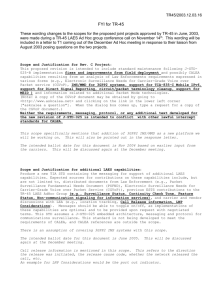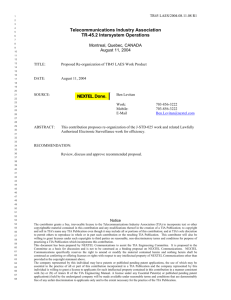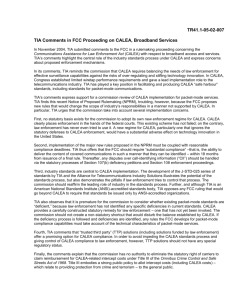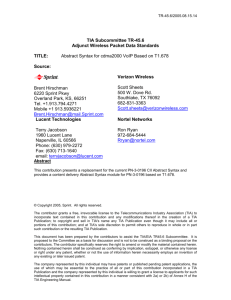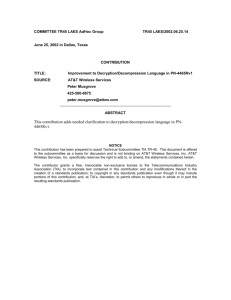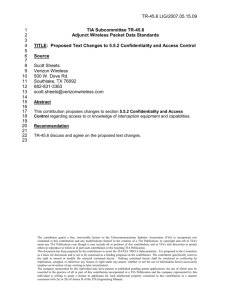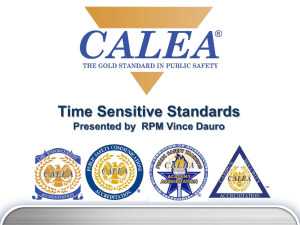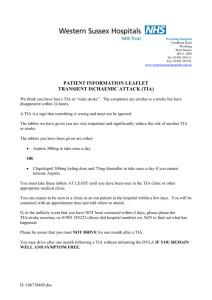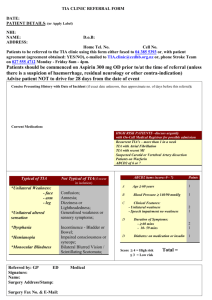050302-37 Nextel LAES_reorg_R_and_R_rev4
advertisement
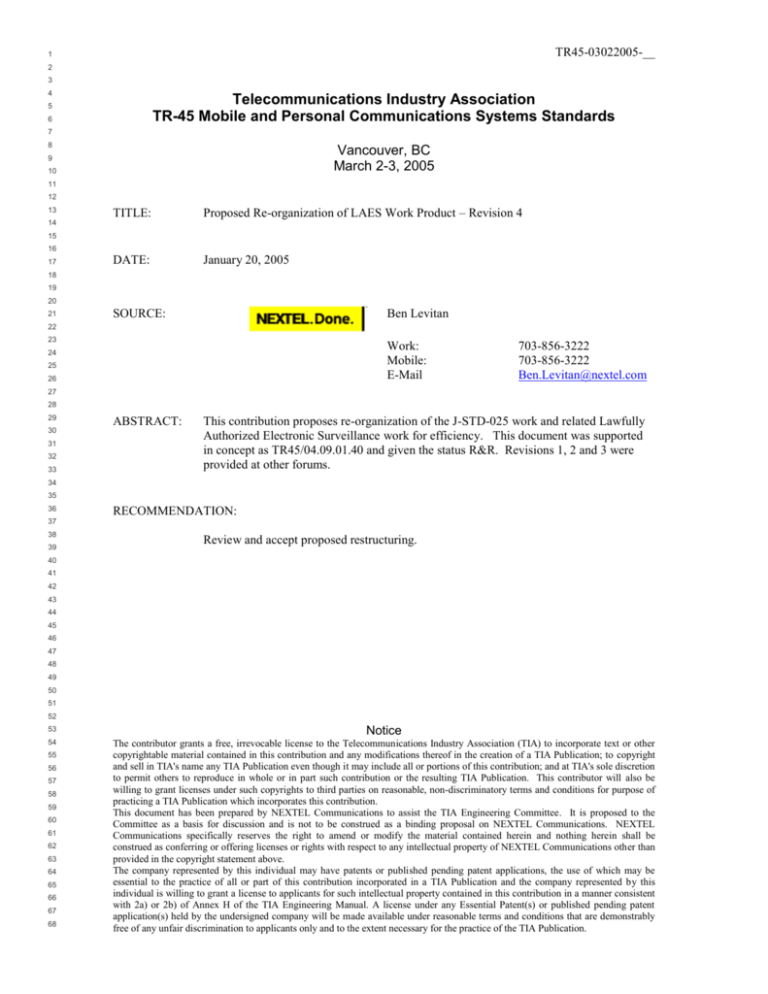
TR45-03022005-__ 1 2 3 4 Telecommunications Industry Association TR-45 Mobile and Personal Communications Systems Standards 5 6 7 8 Vancouver, BC March 2-3, 2005 9 10 11 12 13 TITLE: Proposed Re-organization of LAES Work Product – Revision 4 DATE: January 20, 2005 14 15 16 17 18 19 20 21 SOURCE: Ben Levitan 22 23 Work: Mobile: E-Mail 24 25 26 703-856-3222 703-856-3222 Ben.Levitan@nextel.com 27 28 29 30 31 32 33 ABSTRACT: This contribution proposes re-organization of the J-STD-025 work and related Lawfully Authorized Electronic Surveillance work for efficiency. This document was supported in concept as TR45/04.09.01.40 and given the status R&R. Revisions 1, 2 and 3 were provided at other forums. 34 35 36 RECOMMENDATION: 37 38 39 Review and accept proposed restructuring. 40 41 42 43 44 45 46 47 48 49 50 51 52 53 Notice 54 The contributor grants a free, irrevocable license to the Telecommunications Industry Association (TIA) to incorporate text or other copyrightable material contained in this contribution and any modifications thereof in the creation of a TIA Publication; to copyright and sell in TIA's name any TIA Publication even though it may include all or portions of this contribution; and at TIA's sole discretion to permit others to reproduce in whole or in part such contribution or the resulting TIA Publication. This contributor will also be willing to grant licenses under such copyrights to third parties on reasonable, non-discriminatory terms and conditions for purpose of practicing a TIA Publication which incorporates this contribution. This document has been prepared by NEXTEL Communications to assist the TIA Engineering Committee. It is proposed to the Committee as a basis for discussion and is not to be construed as a binding proposal on NEXTEL Communications. NEXTEL Communications specifically reserves the right to amend or modify the material contained herein and nothing herein shall be construed as conferring or offering licenses or rights with respect to any intellectual property of NEXTEL Communications other than provided in the copyright statement above. The company represented by this individual may have patents or published pending patent applications, the use of which may be essential to the practice of all or part of this contribution incorporated in a TIA Publication and the company represented by this individual is willing to grant a license to applicants for such intellectual property contained in this contribution in a manner consistent with 2a) or 2b) of Annex H of the TIA Engineering Manual. A license under any Essential Patent(s) or published pending patent application(s) held by the undersigned company will be made available under reasonable terms and conditions that are demonstrably free of any unfair discrimination to applicants only and to the extent necessary for the practice of the TIA Publication. 55 56 57 58 59 60 61 62 63 64 65 66 67 68 TR45-03022005-__ 1 2 3 4 5 6 7 8 9 10 11 Goals of this proposal 1) Develop an effective way to quickly develop standards for Lawful Intercept 2) Developed the standards where the most experts on the subsystem or feature being that is the target of the surveillance addition are present. 12 13 14 3) Unbundle surveillance standards so that vendors building only certain functional entities or features can achieve (and offer their customers) safe harbor. 15 16 17 18 19 20 21 4) Enable operators to quickly and easily determine their surveillance obligations and solutions for their particular system. 5) Remove legal discussions from the technical groups. Assure that technical groups only develop solutions for customer requirements rather than argue the legality of those requirements. 22 23 24 Overview of Solution 25 26 a) 27 28 29 30 31 32 33 34 Republish J-STD-025 as a “circuit switched” solution for 2nd Generation networks, and publish it as TIA/EIA-XXX-001-LI (all current implementations of J-STD-025 remain “safe harbor”. J-STD-024 is not rescinded.) b) Develop a project and publish as TIA/EIA-XXX-000-LI (Lawfully Authorized Electronic Surveillance – Overview) to contain all the introduction text developed in J-STD-025-A as a technical introduction to legal intercept and also, to serve as an index to all known “Lawfully Authorized Surveillance Standards” that provide “safe harbor”. 35 36 c) 37 38 39 40 41 42 43 Establish a process for working with the TIA Wireless Communications Division Ad-Hoc on CALEA standards. WDC Ad Hoc will act as a legal resource to technical groups or individual company working in a technical group on CALEA standards to resolve legal questions regarding the interpretation of requirements being developed in the technical groups. d) To assure that the legal status of intercept features are known to users of the standards, all standards for legal intercept or enhanced intercept solutions for law enforcement shall: 44 a. b. 45 46 47 48 49 50 Carry an “LI” suffix on their standard number to indicate Intercept Solution Contain a single page forward indicating that the standard describes features and functionality intended to provide safe harbor for lawful intercept and national laws may limit the use of the standard. A reference to the WDC is provided for questions regarding the use of the standard. 51 52 53 Action Since August 2004 Meeting 54 55 56 This contribution was introduced as TR45/04.09.01.40 at the September 2004 TR45 meeting. Considering this contribution and others at the meeting the following decisions were made: 57 58 59 60 61 62 63 64 65 1) 2) 3) 4) 5) 6) 7) the re-organization of electronic surveillance work supported without objection, by TR45. i work should be done where most subject matter experts are normally in attendance ii ANS J-STD-025 series will be capped at Revision B for now.iii Groups would develop “technical capabilities for surveillance” leaving legal issues out. iv TR45 would look to other groups to address the legal issues on behalf of technical groups .iv TR45 LAES Ad Hoc would not shut down till Default Ballot for J-STD-025-B is done. .iv Author was asked to R&R and work with others to develop this proposal. 66 67 68 02/15/2016 2 of 9 Nextel Communications TR45-03022005-__ 1 2 3 4 5 a. 6 7 8 b. This contribution was socialized and rework, discussed and presented at TR45.2, TR45.6, TR45.2 AHI and also socialized with T1P1 members, CIS representatives, TR45 Chair, WDC CALEA Ad-Hoc Chair and a number of interested TIA members. Input from all above is included in this proposal. 9 10 11 Background 12 13 14 15 16 17 18 19 20 21 This contribution proposes a reorganization of the Lawfully Authorized Electronic Surveillance work. The original work, J-STD-025, initiated as a result of the Communications Assistance for Law Enforcement Act of 1994 (CALEA) addressed circuit switched systems and was appropriately and successfully developed as a joint effort between the wireless and wireline community. Today, a wide variety of networks, systems and technologies have evolved that are under the mandate to support law enforcement. Attempts to add all the new technologies into a single document, J-STD-025 (a circuit switched solution) have been ineffective and confusing. 22 23 24 25 26 27 28 29 30 As an example, providers of new “Press-to-Talk Over Cellular” service cannot use any of J-STD-025 to determine their requirements for CALEA compliance, as PoC is a different service and different platform than what is described in J-STD-025. TR45 LAES Ad-hoc has attempted to insert requirements for such features into their document however, the parallels between circuit switched networks supporting voice services and IP based networks supporting PoC (or other IP based services) are so obscure that the process is difficult and the resulting recommendation would be confusing and ineffective to the vendors of the service who are to realize the solution. 31 32 33 34 35 Further due to unbundling, it’s common to find operators buying portions of their network from different vendors and simply assembling or expanding their network incrementally. This has become possible due to the growth in specialized vendors and well-defined standards. Those vendors find it difficult to achieve CALEA compliance for just their small part of the network. 36 37 38 39 40 41 42 Discussion As new features are rolled out, it is vital that the operators can quickly achieve “CALEA compliance” in order to offer the services as required under the law. 43 44 1. 45 46 47 2. 48 49 50 51 3. 52 53 54 4. 55 56 57 58 59 Developing recommendations for new features or platforms can be achieved quickly if done by the subject matter experts, and done in the same groups that developed the feature. Waiting for a release of a major (and very technically complex) document that is jointly developed is too slow to market, (witness J-STD-025-B, approved for ballot on September 3, 2003v and now on it’s second default ballot after 18 months). The developing of a central index would let operators quickly know what is available on the “standards market” already thus enabling them to select features and platforms that can be CALEA compliant when they go to market. Operators can offer the same service on a wide variety of technology platforms including wireless, cellular, broadband and fixed among others. When selecting a platform and generating an RFP it is essential that the operator can provide prospective bidders with a reference to the CALEA requirements to be included in their bids. An index would speed this process. 60 61 62 63 64 65 66 67 68 02/15/2016 3 of 9 Nextel Communications TR45-03022005-__ 1 2 3 4 5 6 7 8 9 10 11 12 13 Proposal This contribution proposes a reorganization of the Lawfully Authorized Electronic Surveillance work. This contribution further proposes: 1) Republish the “circuit switch solution” work of the former TR45 LAES as a “circuit switched” solution for 2nd Generation networks (TIA/EIA-XXX-001-LI - Project proposal is separate contribution) 14 15 16 17 18 19 2) Republish the “CALEA Overview” work of the former TR45 LAES as TIA/EIA-XXX-000-LI (Lawfully Authorized Electronic Surveillance – Overview) 3) The creating of an index that provides a central index of LI documents 20 21 4) Establish a process for working with the TIA WDC Ad-Hoc on CALEA standards 22 23 24 5) Recommendations on addressing the numbering of Lawful Intercept (LI) and appropriate legal warning for all LI documents. 25 26 27 6) Recommendations on additional process for balloting. 28 29 30 31 32 33 34 35 36 37 38 39 40 41 42 43 44 45 46 47 48 49 50 51 52 53 54 55 56 57 58 59 60 61 62 63 64 65 66 67 68 02/15/2016 4 of 9 Nextel Communications TR45-03022005-__ 1 2 3 4 5 6 Specific Proposal for the Reorganization of the work 7 8 9 10 11 12 13 14 15 16 17 18 19 20 1. Numbering of Recommendations Proposal: All recommendations that address technical solutions for Lawful Intercept shall carry the suffix “-LI” (or other agreed upon common suffix) in their TIA project and standards number. Reason: The previous proposal by Nextel to create a multi-part document would require significant coordination of a single number range across multiple technical working groups. This would be difficult and may not be effective. In order to serve the customer; (those who use and read LI documents) the compromise proposal to append an “-LI” suffix will allow users to easily find relevant document in a search engines or file systems. Further, this frees all groups producing standards to assign numbers to their work per their standard processes (including groups outside of TIA). 21 22 23 24 25 26 27 2. Standard Legal Foreword for LI recommendations Proposal: Each document that defines the technical capabilities to support lawfully authorized surveillance will contain, as it’s first page (following the cover page) a notice of the nature of the technical solution enclosed. Example: 28 Note: Please review this document with your company’s legal advisors. This document describes features, services or functions, which may be used to support legally, authorized electronic surveillance, only. Local or national laws in your United States (and other countries) may regulate the use of these features. The features in this document (check one): [ ] Support features which are required by law CALEA [ ] Additional enhancements that may be offered to law enforcement 29 30 31 32 33 34 35 36 37 38 Reason: To indicate the special nature of the documents on surveillance, there needs to be some text to address the situation so it is understood that these are not features and capabilities that can be offered to the general public. CALEA requires that use of the feature by operators be strictly recorded, even for testing. Also: A consistent message that is provided in each recommendation will simplify the need for technical groups to discuss legal issues. 39 40 41 42 43 44 45 46 47 48 49 50 51 52 53 54 3. LI Solutions are unbundled by Feature and / or Technology Proposal: Propose a “principle” of developing CALEA solutions for new features or platforms as those platforms are developed. Similar to “principles” in ASN-41 regarding “backwards compatibility” and “signaling reduction” in 3GPP2. Reason: 55 56 57 58 The intercept access information available for a similar service may be different depending on the technology employed to support it. The reality is that requirements developed recommend for lawfully authorized electronic surveillance for circuit may not have parallels in the IP system. Developing “intercept” while developing the feature may speed the process. 59 60 61 62 63 64 65 4. Work with WCD CALEA Ad-Hoc to support “Legal Issues” Proposal: Assign TIA’s Wireless Communication Division Ad Hoc on CALEA as the “legal advisor to TIA technical groups. Adopt the procedure shown in this section for resolving “legal issues”. 66 67 68 02/15/2016 5 of 9 Nextel Communications TR45-03022005-__ 1 2 3 4 5 6 Reason: 7 8 9 10 11 12 13 14 15 16 17 18 19 20 21 Decision at TR45 9/2004 to remove legal issues from technical discussion and allow groups to focus on “technical realization of capabilities” In Standards development, “Requirements” are generally the domain of the “customer” and the “implementation and architecture” are the domain of the developers, however in the case of Lawfully Authorized Interception, US law defines the requirements on behalf of the eventual customer. Therefore, when the issue of requirements comes up, both the end customer (law enforcement) and the developers (operators/vendors/developers) discuss and attempt to draw a conclusion as to the intent of the writer of the requirement (the US Congress, US Courts or the FCC). This discussion has in the past stopped the progress of work, while “non-lawyers” attempt to resolve the intent. Procedure: This procedure is recommended for all technical groups involved in CALEA technical realization. The TIA WCD CALEA Group will act as a resource to technical groups if they have questions regarding the requirements for any technical project. The proposal is detailed in Appendix A of this contribution is summarized here. 22 23 24 25 26 27 28 29 30 31 32 33 34 35 36 37 38 39 40 41 42 43 44 45 46 47 48 49 50 51 52 53 54 55 56 57 58 59 60 61 62 63 64 65 66 1) Scope of Process: Only issues of “interpretation of requirements” can be sent to the Legal Committee for a decision. Issues of “readily available” are judgments made by members based on their knowledge of their own networks and capabilities and are generally not subject to a legal decision 2) Responsibilities: It is the responsibility of the technical committees chairman or acting chairman to end discussion of any legal discussion arising. If the technical committee cannot come to a quick understanding of the requirement under discussion, the chair is obliged to end discussion and asked the parties to initiate the “legal liaison process” 3) Initiation of Process: Any technical representative working on realization of technical requirements for Lawfully Authorized Intercept initiates the process. 4) Liaison Requirement: Any party wishing to issue an “inquiry” must do so in writing. The process will be that a liaison is sent to the WDC CALEA Ad Hoc. In order to avoid the problem of any party trying to delay work by issuing a lot of challenges, the initiator of the complaint is considered the sponsor and must produce the liaison (per WDC CAH requirement to be determined by them.). 5) Recording and Notification The initiator will provide the liaison(s) to the chairman of the meeting who will record it in the minutes and forward to WDC CAH. Any other parties wishing to provide supporting information on their (opposing position) will have the right to assist in drafting the liaison so as to provide all sides of the issue. There is no requirement to complete the liaison at the meeting however, work can continue until a challenge is issues by a sponsor. 6) Action following a Challenge: It is the responsibility of the chairman to work around the issue that has been challenged until WDC has issued a decision. The chairman may opt to: a. Set the issue aside and work on other aspects of the standard b. Ask that participants develop two solutions if only one of two outcomes is expected. c. Report to the parent committee that the group has reached a “stop point” due to an unresolved issue and request that the work plan be suspended on the project pending the outcome of the challenge. 7) Action following the decision: The chairman, editor and sponsor(s) of the challenge will be notified of the outcome (per WDC defined procedures). The chairman will proceed based on the decision (or potentially non-decision if the issue a) is determined not to be under the WDC purview, b) can’t be decided due to pending court or FCC decision.) This will be defined in the minutes of the meeting. 8) Special Action for Balloting: All inquires and decisions resulting will be included in the draft of the standard in a special Appendix shown as “Legal Issues”. This section will not become a part of the published standard however will remain in the document during balloting so that members who are reviewing the document and have legal questions can refer to the Appendix to determine if their issue was addressed during deliberation of the standard. If their issue was not addressed, it can be provided as a “ballot comment” marked “legal” and deliberated by the group during ballot deliberation. It is handled per this procedure and if no quick decision is made on the issue, or no 67 68 02/15/2016 6 of 9 Nextel Communications TR45-03022005-__ 1 2 3 4 member present wishes to sponsor and draft a challenge on the issue, the commenter will receive a notice as to the outcome of their ballot comments (as usual) with an additional notice that they have the right to petition the WDC on this issue. 5 6 7 8 9 10 5. Additional foreword for CALEA documents to indicate customer “options” 11 12 13 Proposal: Add text (or similar) to Legal Forward for CALEA solutions: 14 The 103th United Stated Congress in 1994 passed Public Law 103-414, Communications Assistance for Lawfully Authorized Electronic Surveillance (CALEA) which requires Communications Carriers to provide Assistance to law enforcement in a standardized manner for all current and future telecommunications features which they offer. The law has four basic requirements: 1. Expeditiously intercept call content 2. Expeditiously intercept call identifying information 3. Deliver data to Law Enforcement at a location away from the carriers premise 4. Make the system unobtrusive and minimize interference. Protect all identities. 15 16 17 18 19 20 21 22 23 24 25 US law provides that equipment built to a publicly available standard shall provide safe harbor from violation of this law insofar as the FCC or a US Court of Law does not successfully challenge the appropriateness of this document to comply with Public Law 103-414. 26 27 28 29 30 31 NOTICE: There may be other implementations possible to provide a user of the features described in this recommendation a legal safe harbor. The LI index, TIA-XXXX-LI may list some of these other standards. It is recommend that you seek the advice of your legal council prior to implementing services that require CALEA compliance. 32 33 34 35 36 37 38 39 40 41 Reason: The goal is to provide the customer with information that will enable them to offer their services in a legal manner and further encourage them to seek their corporate council in working on CALEA issues. There may be a number of methods they can use and they should be enabled to make an informed decision. 42 43 44 45 46 47 6. Specific Documents to be published using J-STD-025-B as the base Proposal: This topic is the subject of two separate contributions but is summarized here. Specific Proposal: 48 49 50 51 52 A project number should be sought to develop a multipart document that will supercede J-STD-025-B. For the purposes of this contribution it will be assumed that this project will be published as TIA-025D. Text from the current 2nd Default Ballot of J-STD-025-B will be used (in its current state. It is not expected that the project needs to wait for ballot resolution.) 53 54 55 56 57 58 59 60 61 62 a) TIA-025-000-D-LI – Technical Capabilities for Lawfully Authorized Interception Overview Part I: Introduction to CALEA – This section discusses the purpose and legal mandate for CALEA. Much of the existing discussions already in J-STD-025 series can be kept in this section. Part II: Description of CALEA – This section is the Stage 0 description of LAES. Much of this is already well discussed in J-STD-025 and can be reused in this section. Also the Stage 1 descriptions of CALEA in J-STD-025 are appropriate. 63 64 65 66 Part III: Definitions and Acronyms for LAES – This section can be pulled right from the existing LAES J-STD-025 documentation 67 68 02/15/2016 7 of 9 Nextel Communications TR45-03022005-__ 1 2 3 4 5 Part IV: Encoding for LAES – This section discusses the LAESP developed for communications to the LEA equipment. Much of the text already in the protocol section of J-STD-025 is still valid. 6 7 8 9 Part V: NEW SECTION – Index to LAES recommendations for communications technologies. This section is simply a living list of recommendations that support CALEA compliance. It may contain a short description of each technology. An example of the section is shown: a. Public Switched Telephone Networks – J-STD-025-B published by TIA. Provides safe harbor for telecommunication networks that provide circuit switched telephony services. b. Multi-media Messaging Service Platforms - Recommendation XXX published by YYY. Provides safe harbor for telecommunication platforms that support Multimedia Messaging. c. Broadband Networks – Recommendation AAA published by BBB. Provides safe harbor for stand-alone broadband networks. d. PoC – Recommendation CCC published by DDD. Provides safe harbor for Push-toTalk over Cellular Networks. 10 11 12 13 14 15 16 17 18 19 20 21 22 23 24 25 26 27 28 29 30 31 b) TIA-025-001-D-LI – Technical Capabilities for Lawfully Authorized Interception – Support for Circuit Switched Telecommunications Systems Public Switched Telephone Networks – This section can be pulled right from the existing LAES J-STD-025 documentation. This provides the safe harbor for telecommunication networks that provide circuit switched telephony services. 32 33 34 35 36 Action Requested 37 38 39 40 41 42 43 44 45 46 47 48 Approve the six individual proposals: No Proposal . 1 Approve “-LI” suffix for all LI Recommendations 2 Approve “Boilerplate Legal “Forward” for all LI Standards 3 Add “principle” to ANS standard to develop LI per project 4 Endorse liaison procedure and assign WDC CAH as entity 5 OK, Notice of possible alternate solutions for safe harbor 6 Approve New Circuit Switch and Overview/Index Standards Group Decision 49 50 51 Action on this proposal to date 52 53 54 55 56 57 58 59 60 61 62 63 1) Per TR45 LAES (Aug. 11, 2004): Supported in concept the idea of breaking up J-STD-025 into technology and service specific volumes. Author directed to present this contribution at the TR45 meeting on September 1, 2004 and coordinate this effort with other on going efforts to reorganize the work of LAES. 2) Per TR45 Meeting (Sept 1-2, 2004): See ACTION SINCE AUGUST 2004 Meeting. . 3) Per TR45.6 Meeting (October, 2004): TR45.6 approved the work to develop a recommendation on wiretap capabilities for VOIP. TR45.6 also approved the project requests of Sprint and Verizon to start a project on Interception for Push-to-Talk over Cellular for “Pre-3GPP2 systems” of PoC. 64 65 66 67 68 02/15/2016 8 of 9 Nextel Communications TR45-03022005-__ 1 2 3 4 4) Per TR45.2 Meeting (October, 2004) TR45.2 approved the formation of an ad hoc group to develop a requirement for interception for MMD networks under the name TR45.2 AHI (Ad Hoc on Interceptions). It is agreed that there is some overlap between the work in TR45.6 and TR45.2. 5 6 7 8 9 5) January 2005 - Revised and presented to TR45.2 Meeting (Vancouver) for information and discussion. Also presented to TR45.6 Meeting. Comments accepted and incorporated into Revision 3 of this contribution. 10 11 12 13 6) January 2005 – Revised and present to TR45.2 AHI Meeting in Tampa, Florida. Comments incorporated. 14 15 16 17 18 19 20 21 22 23 24 25 i Quoted from TR-45 Meeting Report, Approved 10/08/04 (T#8349) Quoted from TR-45 Meeting Report, Approved 10/08/04 (T#8349) iii Quoted from TR-45 Meeting Report, Approved 10/08/04 (T#8349) iv Paraphrased from T#8349 v TR45 LAES Meeting Report - TR45.LAES/2003.09.03.13 ii 26 27 28 29 30 31 32 33 34 35 36 37 38 39 40 41 42 43 44 45 46 47 48 49 50 51 52 53 54 55 56 57 58 59 60 61 62 63 64 65 66 67 68 02/15/2016 9 of 9 Nextel Communications
